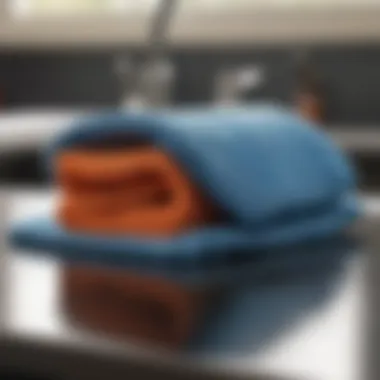Essential Kitchen Cleaning Tools for Every Home


Intro
Maintaining a clean kitchen is crucial for health and aesthetics. With various cleaning tools available, understanding their functions is necessary for effective kitchen upkeep. This guide highlights essential tools used in kitchens, considering different materials and applications. Moreover, knowing how to use and care for these tools ensures longevity and efficiency.
Feature Spotlight
When it comes to kitchen cleaning tools, several features enhance their overall effectiveness. Understanding these features allows users to make informed choices, optimizing their kitchen environments.
Exceptional Material Choices
The materials used in cleaning tools can significantly influence their performance. Here are some common materials:
- Microfiber: Soft and absorbent, microfiber cloths are excellent for picking up dust and moisture without scratching surfaces.
- Stainless Steel: Durable and resistant to corrosion, stainless-steel scrubbers are ideal for tough grime, especially on cookware.
- Natural Fibers: Tools made from natural materials like coconut husk or bamboo are eco-friendly and effective.
Selecting tools made from high-quality materials ensures efficiency in cleaning tasks and sustainability in usage.
Practical Design Features
An ergonomic design can make cleaning tasks easier. For instance, tools with comfortable grips reduce strain during long cleaning sessions. Additionally, flexibility in design helps reach into tight spaces. Consider the following:
- Extendable Handles: Useful for high shelves or deep corners.
- Multifunctional Tools: Some scrubbing tools may have both a sponge side and a scouring side, enhancing versatility.
Location Highlights
A clean kitchen does more than just look good; it promotes comfort and invites creativity in cooking. The cleanliness of a kitchen reflects directly on the space's functionality and usability.
Essential Tools for Every Kitchen
Certain tools are indispensable. Here is a curated list of must-have kitchen cleaning tools:
- Dishwashing Sponge: Perfect for general cleaning of plates and cutlery.
- All-Purpose Cleaner: Versatile for various surfaces in the kitchen.
- Bristle Brush: Ideal for scrubbing pots and pans without causing damage.
- Dish Towels: To dry dishes and wipe surfaces efficiently.
These tools are basic yet vital for ensuring cleanliness and efficient kitchen operation.
Innovative Alternatives
As homeowners become more environmentally conscious, alternative cleaning solutions gain popularity. Some options include:
- Homemade Cleaners: Combining vinegar and baking soda offers an eco-friendly solution for tough stains.
- Reusable Cloths: Instead of disposable paper towels, reusable cloths reduce waste while being effective for cleaning.
"Sustainable practices in kitchen cleaning not only help the environment but also promote a healthier living space."
Understanding the range of cleaning tools available empowers users to keep their kitchens spotless while being efficient and eco-friendly. The choice of appropriate tools, based on material and design, contributes to both the aesthetic and functional aspects of the kitchen. As we move forward in this guide, we will delve deeper into specific categories of cleaning tools and their maintenance.
Preamble to Kitchen Cleaning Tools
A clean kitchen is essential for every home, not only for aesthetic reasons but also for health and safety. The kitchen serves as a hub for food preparation, and maintaining its cleanliness is crucial to prevent foodborne illnesses. This section introduces the importance of kitchen cleaning tools and how they contribute to a healthy kitchen environment.
Kitchen cleaning tools are designed to tackle various tasks, from basic wiping and scrubbing to specialized cleaning of hard-to-reach surfaces. Understanding the specific roles and benefits of these tools can enhance both efficiency and effectiveness of cleaning efforts. Proper use of the right tools can drastically reduce the time spent on cleaning while ensuring that surfaces are sanitized adequately.
Specific Elements of Kitchen Cleaning Tools
These tools can range from simple items like sponges and cloths to advanced mechanical aids. Each tool serves a purpose, addressing specific cleaning needs such as:
- Surface cleaning: Removing grime from countertops or cuts.
- Dishwashing: Ensuring utensils and plates are free from food residue.
- Deodorizing: Eliminating odors that can arise from food storage.
Benefits of Using the Right Tools
Using appropriate kitchen cleaning tools improves not only cleanliness but also safety. For instance, using specialized brushes can prevent scratching delicate surfaces, while eco-friendly products minimize exposure to harmful substances. This attention to detail fosters a kitchen environment that is conducive to both health and enjoyment.
Considerations About Kitchen Cleaning Tools
When selecting cleaning tools, it is essential to consider both material and purpose. Some materials are better for specific tasks than others, and long-term usability is an important factor. For example, tools made of natural fibers are often biodegradable and eco-friendly, making them a good option for environmentally conscious homeowners. Others may prioritize durability and ease of use, favoring tools made of synthetic materials.
The Importance of Cleanliness in the Kitchen
Maintaining cleanliness in the kitchen is not merely a matter of aesthetics; it is a fundamental aspect of health and safety. A clean kitchen environment plays a crucial role in food preparation, directly impacting the well-being of everyone who uses the space. A dirty kitchen can harbor bacteria, pests, and allergens, which may lead to foodborne illnesses and other health issues.
Health Benefits
One of the primary reasons for keeping the kitchen clean is health. Food preparation areas are prone to contamination. Research indicates that one in six Americans fall ill from foodborne diseases each year. By employing effective cleaning practices, such as sanitizing surfaces and storing food properly, these risks can be significantly minimized. Regular cleaning helps prevent cross-contamination. This concept refers to harmful bacteria from raw foods, like poultry, spreading to ready-to-eat items.


Psychological Impact
A clean kitchen can also have psychological benefits. Clutter and mess can lead to feelings of stress and anxiety. When surfaces are clear and everything is in order, the mind can focus better. Cooking and meal prep feel more enjoyable in an organized environment. It encourages experimentation in cooking and invites a more pleasant experience for family meals.
Efficiency in Cooking
Another advantage is the increase in efficiency. A well-maintained kitchen allows for smoother cooking processes. When tools and ingredients are organized and clean, it reduces the time spent searching for items. This organized approach leads to a more pleasant cooking experience and a potentially healthier diet.
Long-term Cost Savings
Investing time in kitchen cleanliness can lead to long-term savings. Dirty tools and equipment can wear out faster. Regular maintenance extends the life of kitchen tools and appliances, saving money in replacements. Furthermore, good hygiene reduces the risk of pest infestations, which can lead to expensive extermination jobs.
Community and Social Responsibility
Lastly, cleanliness fosters a sense of community. When friends and family gather in a clean kitchen, it creates a welcoming atmosphere. This can be especially vital for those who enjoy hosting events or small gatherings. Cleanliness reflects respect for guests and reinforces social bonds.
"A clean kitchen is a reflection of respect for food, the cook, and those who share the meal."
Types of Cleaning Tools
Understanding the various types of cleaning tools is crucial for maintaining an effective and organized kitchen. This section categorizes cleaning tools into three broad categories: basic, specialized, and eco-friendly. Each category serves a distinct purpose, providing benefits that can enhance the cleanliness and functionality of your kitchen. Utilizing the appropriate tools can save time and effort, which can lead to a more efficient cleaning routine. Moreover, the right tools also help to ensure that surfaces are thoroughly and effectively cleaned, producing a healthier home environment.
Basic Cleaning Tools
Sponges
Sponges are often the first line of defense when it comes to routine kitchen cleaning. Their soft texture allows for gentle cleansing of various surfaces without causing scratches or damage. They are particularly useful for absorbing liquids, making them suitable for quick spills as well. One of the key characteristics of sponges is their versatility. They can be used with a variety of cleaning solutions, adapting to tasks ranging from washing dishes to cleaning countertops. However, a major disadvantage is that sponges can harbor bacteria if not regularly cleaned or replaced. Proper care includes washing them frequently to ensure they remain hygienic, which is necessary for maintaining an effective kitchen cleaning strategy.
Dish Cloths
Dish cloths are quintessential tools in any kitchen. They come in various materials, from cotton to microfiber, which affects their absorbency and durability. One of their primary roles is to aid in drying and wiping surfaces. This makes them indispensable during the post-cooking clean-up process. The absorbent nature of dish cloths allows them to pick up crumbs, spills, and other debris effectively. However, similar to sponges, dish cloths require regular washing to prevent bacterial growth. They need to be replaced periodically, especially when they show signs of wear and tear, to ensure continued effectiveness.
Scrub Brushes
Scrub brushes are designed for tougher jobs. With their stiff bristles, they excel at removing stubborn grime and food residues that sponges and cloths may not be able to handle. These tools are particularly beneficial when cleaning pots, pans, and surfaces that have been exposed to heavy grease or baked-on food. Their key feature is their strength and ability to withstand rigorous use. However, care must be taken not to scratch delicate surfaces. Maintaining scrub brushes involves rinsing them after each use and allowing them to dry properly, to prevent mildew or damage to the bristles.
Specialized Cleaning Tools
Grill Brushes
Grill brushes are specifically tailored for cleaning grills and barbecues. Their unique design, often featuring stainless steel bristles, allows them to reach between grates effectively, removing food particles and grease. The durability of grill brushes enables them to tackle difficult cleaning tasks without falling apart. However, care is needed to avoid damaging the grill surfaces, especially on ceramic or painted grates. Regular inspection for worn bristles is essential, as this can negatively affect their cleaning efficiency and safety.
Microfiber Cloths
Microfiber cloths have become popular due to their superior cleaning capabilities. Their fine fiber structure allows them to pick up dust, dirt, and bacteria more effectively than traditional cloths. They can be used dry for dusting or damp for cleaning surfaces, providing versatility in cleaning approaches. An essential benefit of microfiber cloths is that they are reusable and can withstand multiple washes, making them both economical and eco-friendly. However, they may require specific washing practices to preserve their effectiveness over time, such as avoiding fabric softeners.
Magic Erasers
Magic Erasers are often seen as a go-to solution for removing tough stains. Their unique material, melamine foam, creates a mildly abrasive surface that can scuff away marks from walls, countertops, and other surfaces. This characteristic makes them incredibly useful for various cleaning tasks, especially on surfaces that show wear. One of the advantages is their ability to clean without the need for additional cleaning chemicals. Nevertheless, they can wear down quickly and should be used with caution on delicate finishes, as their abrasive quality may cause damage.
Eco-Friendly Cleaning Tools
Bamboo Brushes
Bamboo brushes are growing in popularity among environmentally conscious consumers. Their primary benefit is that bamboo is a sustainable material, making these brushes an excellent choice for reducing plastic waste in the kitchen. The natural bristles are effective for cleaning, providing a gentle yet thorough job on various surfaces. An advantage of bamboo brushes is their biodegradable nature. However, they require proper care to ensure longevity, such as thorough cleaning and drying after each use.
Reusable Cloths
Reusable cloths offer an eco-friendly alternative to single-use paper towels. They come in various materials and are designed to be washed and reused many times. This characteristic not only reduces waste but also saves money in the long run. The effectiveness of reusable cloths depends largely on their material, with microfiber options providing superior absorbency. One consideration is that they need regular washing to maintain hygiene and effectiveness, and worn cloths should be replaced.
Natural Cleaning Sprays
Natural cleaning sprays provide a chemical-free method for keeping the kitchen clean. They typically use plant-based ingredients that are less harsh on the environment and safer for health. These sprays can effectively cut through grease and grime while being gentle on surfaces. A significant advantage is their pleasant scents, which add freshness while cleaning. The downside might be that they are not always as powerful as their chemical counterparts for heavy-duty cleaning tasks.
Cleaning Tools by Material
Understanding the types of materials used in kitchen cleaning tools is essential for making informed decisions about their effectiveness and longevity. Different materials come with unique advantages and drawbacks, which can significantly influence the overall cleaning experience in a kitchen.
When selecting cleaning tools, it is important to consider how the material impacts cleaning efficiency and the environmental footprint. This section will detail various materials used in kitchen cleaning tools, focusing on plastic, metal, and natural fibers.
Plastic Cleaning Tools


Advantages and Disadvantages
Plastic cleaning tools, such as spatulas, brushes, and buckets, are quite popular due to their lightweight nature and affordability. They can be easily manufactured in various shapes and colors, adding a degree of flexibility to their design. One of the key advantages of plastic is its resistance to moisture, preventing the growth of bacteria, especially in wet environments.
On the other hand, plastics have potential disadvantages, such as environmental concerns regarding their disposal. Most plastic cleaning tools can take centuries to decompose in landfills. Moreover, some low-quality plastics may degrade over time, leading to cracks and brittleness.
Durability Concerns
In terms of durability, plastic cleaning tools vary widely based on manufacturing quality. Higher-grade plastics tend to withstand frequent use better than cheaper alternatives. It is crucial to consider whether the plastic tool is BPA-free and safe for food contact. Some users also express concerns about heat resistance. If subjected to high temperatures, certain plastics may warp or melt, impacting their functionality.
Metal Cleaning Tools
Types of Metal Cleaning Tools
Metal cleaning tools include items like stainless steel scrubbers, pot and pan brushes, and scrapers. These tools are favored for their strength and effectiveness in tackling tough cleaning tasks. Stainless steel, in particular, is prized for its resilience against rust and staining, making it a sought-after choice in kitchens.
Metal tools offer the advantage of longevity and can often be reused many times without significant degradation in quality. However, they may scratch or damage certain surfaces if not used carefully, making them suitable mostly for robust kitchenware.
Maintenance Tips
To maintain metal cleaning tools, it is essential to emphasize regular cleaning and proper storage. After each use, tools should be rinsed and dried thoroughly to prevent rusting. Keeping them stored in a dry area is also crucial. Users can consider applying a thin coat of oil to metal scrapers or scrubbers to enhance their longevity and functionality.
Natural Fiber Cleaning Tools
Benefits of Natural Fibers
Natural fiber cleaning tools, such as those made from sisal or coconut coir, offer an eco-friendly alternative for conscious consumers. The primary benefit of these tools is their biodegradable nature. Unlike plastic counterparts, natural fibers break down more quickly and do not contribute as significantly to landfill waste. They also tend to be gentler on delicate surfaces.
Additionally, natural fibers can effectively absorb moisture and wipe surfaces without leaving behind scratches. Users who prioritize sustainability will find these tools align well with their goals.
Eco-Conscious Choices
Choosing eco-conscious cleaning tools is becoming a significant trend among environmentally aware consumers. Natural fiber tools often employ sustainable harvesting practices, thus minimizing their ecological footprint. Selecting such tools not only supports a cleaner kitchen but also places emphasis on more responsible consumption habits.
Ultimately, understanding the different materials in kitchen cleaning tools helps consumers make choices that align with their needs and values. Selecting the right tool can greatly enhance both effectiveness and efficiency, making kitchen cleaning a more manageable task.
Proper Usage of Cleaning Tools
Proper usage of cleaning tools plays a crucial role in maintaining a hygienic kitchen. Understanding how to utilize these tools effectively can determine not only the success of your cleaning efforts but also uphold the safety of your food preparation areas. By implementing proper techniques, you minimize the risk of cross-contamination and ensure that surfaces are sanitized effectively. Each tool has its designated purpose and using it correctly enhances its effectiveness while optimizing your cleaning routine.
Preventing Cross-Contamination
Cross-contamination is a significant concern in kitchens, where raw foods can harbor harmful bacteria. To prevent this issue, it is essential to assign specific cleaning tools to particular areas or tasks. For example, using one sponge for dishes and another for countertops helps minimize the risk of bacteria transfer.
Using color-coded sponges and cloths is a strategic choice. Assigning colors like green for vegetables and red for meats creates a clear distinction. Additionally, regularly washing and sanitizing cleaning tools prevents the build-up of bacteria, reinforcing the importance of proper usage.
Maximizing Efficiency
Efficiency in cleaning translates to less time spent scrubbing and more time enjoying a tidy kitchen. When you understand the functionality of each cleaning tool, you can use them to their full potential. For instance, a microfiber cloth can pick up dust and allergens quickly, while a scrub brush might be necessary for tough stains.
Creating a cleaning schedule can significantly enhance efficiency. Knowing when to use each tool prevents last-minute scrambles and leads to a more organized approach. This means focusing your energy on high-use areas regularly while employing deeper cleaning techniques for less frequently used spots.
Cleaning Techniques to Employ
Scrubbing vs. Wiping
Scrubbing and wiping are two primary methods used in kitchen cleaning. Scrubbing involves using a brush or abrasive cloth to eliminate tough grime and stains. It often requires more effort, as it physically removes debris from surfaces. On the other hand, wiping typically involves using a damp cloth or sponge to remove lighter residue, such as spills.
Scrubbing is beneficial for areas with stubborn grime, such as burnt-on food in pots or pans. However, improper scrubbing can scratch surfaces, so care is necessary. Wiping is easier on surfaces and often faster. However, it may not achieve the same level of sanitation as scrubbing in certain situations. Choosing between these techniques depends on your immediate cleaning needs and the condition of your surfaces.
Using the Right Cleaning Solution
Choosing the correct cleaning solution is vital to achieving the desired results in your cleaning efforts. Various cleaning solutions serve specific purposes, such as degreasers for kitchen surfaces or disinfectants for cutting boards.
The notable characteristic of using the right cleaning solution is that it enhances the effectiveness of your cleaning process. It helps to break down stains and kill bacteria more efficiently. However, it's crucial to be mindful of any chemical reactions that may occur with certain surfaces.
Additionally, some solutions require dilution before use, so following manufacturer instructions is important. Opting for natural cleaning options can also be beneficial, depending on personal preferences and allergies. Ensuring that the chosen solution aligns with the surface being cleaned promotes a truly effective cleaning experience.
Not only does proper usage of cleaning tools help maintain a clean kitchen, but it also contributes significantly to overall health and safety.
Maintenance of Kitchen Cleaning Tools


Proper maintenance of kitchen cleaning tools is essential not just for prolonging the life of these tools, but also for ensuring a hygienic cooking and dining environment. Without adequate care, cleaning tools can become breeding grounds for bacteria, leading to cross-contamination and potentially harmful situations in the kitchen. Thus, investing time and effort into maintaining these tools is crucial for both safety and efficiency.
Storage Solutions
The way you store your cleaning tools greatly impacts their lifespan and effectiveness. Proper storage helps prevent damage and keeps tools organized. For example, using designated containers or racks can minimize wear on sponges and brushes, keeping them readily available when needed. Consider placing cleaning tools in dry areas to prevent moisture buildup that can cause mold and bacteria growth. Likewise, try to separate tools used for different tasks. This way, you can avoid cross-contamination effectively.
Cleaning and Care Practices
Washing and Disinfecting Sponges
One key aspect of maintaining kitchen cleaning tools is washing and disinfecting sponges regularly. Sponges absorb food particles and liquid, making them susceptible to bacteria. It is advised to wash sponges using hot, soapy water regularly. Subsequently, disinfecting them in a microwave for a minute or soaking in a bleach solution can help in eradication of harmful pathogens. This practice not only enhances their lifespan but also contributes significantly to kitchen hygiene.
Key characteristic: The ability to keep surfaces clean while being cheap and accessable makes sponges a beneficial choice. They are versatile and can adapt to several types of cleaning tasks, from wiping surfaces to scrubbing pots.
Unique feature: Sponges’ porous nature allows them to trap and hold debris but this can also lead to bacterial growth if they are not properly maintained. Thus, regular washing and disinfecting is crucial to balance these traits.
Replacing Worn Tools
Replacing worn tools is another important part of maintenance. As tools like scrubbing brushes and kitchen cloths age, they become less effective, making it crucial to recognize when they need to be replaced. Worn tools might not clean surfaces properly, leading to potential buildup of grime and bacteria. Hence, identifying and replacing these tools on time helps maintain a clean environment.
Key characteristic: The effectiveness of cleaning tools can deteriorate significantly with use. Prioritizing replacements means you invest in tools that work efficiently and contribute to a cleaner kitchen.
Unique feature: When you replace worn tools, you are not only improving cleaning effectiveness but also minimizing health risks. Old tools, beyond a point, can cause more harm than good. Therefore, timely replacements are an essential part of proper kitchen hygiene practices.
Signs of Replacement
Recognizing the signs that indicate a need for replacement can save both time and effort in the long run. For example, discoloration, loss of shape, or a rancid smell are all indicators that a tool may need to be discarded. Frequently inspect all cleaning tools for these signs to determine if they serve their purpose effectively.
Regular attention to these details ensures that your kitchen remains a healthy environment. Taking care of your cleaning tools is not merely a chore; it is a commitment to maintaining the cleanliness and overall integrity of your space.
Innovative Cleaning Technologies
Innovative cleaning technologies have transformed the way we maintain kitchens. These advancements introduce efficiency and ease in cleaning tasks, ensuring that homeowners keep their spaces both spotless and pleasant. With innovative tools, the burden of cleaning is lessened, allowing for more time to be spent on activities other than chores. Understanding these technologies is imperative for those looking to optimize their home hygiene. They represent a modern approach, integrating smart solutions into daily routines, which can be both beneficial and time-saving.
Mechanical Cleaning Aids
Robotic Vacuum Cleaners
Robotic vacuum cleaners are a standout among mechanical cleaning aids. They symbolize convenience. Their key characteristic is automation. With the ability to navigate various surfaces, they enhance the overall cleanliness of the kitchen. Many of these devices operate through mobile apps, making them easy to manage. Their unique feature is the capacity to clean autonomously. This means that once programmed, they can perform regular cleaning without constant supervision.
The advantages are considerable. They save time, especially for busy individuals. However, they also have limitations; for example, they may struggle in corners or under furniture. Additionally, their initial cost can be a barrier for some users, even though they often prove to be a worthwhile investment over time.
Ultrasonic Cleaners
Ultrasonic cleaners utilize high-frequency sound waves to clean surfaces effectively. Their main aspect is deep cleaning. They excel at removing grime and residue from small items like utensils and jewelry. The key characteristic of ultrasonic cleaners is their ability to reach every nook and cranny of an object through cavitation, making them an excellent choice for specific cleaning tasks.
This tool is popular in both home and commercial cleaning due to its efficiency. A unique feature is the gentle yet thorough cleaning process that doesn’t harm the items being cleaned. While they are highly effective, their limitations include the need for proper maintenance and the fact that larger items may not fit into standard models, making them less versatile than other cleaning tools.
Smart Cleaning Solutions
App-Controlled Devices
App-controlled devices are an innovative solution within smart cleaning technologies. Their specific aspect lies in usability and control. By using an application, users can manage their cleaning devices from anywhere, making it need more user-friendly. The key characteristic is remote operation, which means tasks can be scheduled at convenient times.
This feature is advantageous for maintaining a clean kitchen with minimal effort. However, one consideration is reliability; if the Wi-Fi is down, users may lose control of the devices, making them less effective under certain circumstances.
Automated Cleaning Systems
Automated cleaning systems provide a comprehensive approach to kitchen hygiene. They integrate multiple cleaning tasks into one solution. The primary aspect of these systems is synergy. They often combine vacuuming, mopping, and sanitizing all in one device. This system is appealing because of its multifunctionality, simplifying the cleaning process significantly.
A notable feature is their programmability, allowing users to set cleaning schedules based on individual needs. However, the downside could be their high investment cost compared to conventional tools, which may deter some users.
Innovative cleaning technologies signify a leap forward in kitchen maintenance. By integrating automation and smart features, these tools enhance the cleaning process substantially.
Ending
In closing, the significance of proper kitchen cleaning tools cannot be overstated. A clean kitchen is the epicenter of any home, directly influencing health, hygiene, and overall efficiency in food preparation. As discussed in this article, investing in quality cleaning tools and understanding their usage can transform your kitchen into a pristine environment.
The benefits of maintaining a clean kitchen go beyond aesthetic appeal. Regular cleaning helps prevent the buildup of harmful bacteria and allergens, which can pose health risks. Tools like microfiber cloths and natural cleaning sprays are particularly effective in eliminating germs without introducing harsh chemicals into the food space.
Moreover, choosing the right materials for cleaning tools can enhance durability and improve overall cleaning performance. For instance, metal scrub brushes are ideal for tough grime, whereas bamboo brushes offer an eco-friendly approach. The choice you make here should align with your cleaning habits and preferences.
Proper maintenance of these tools ensures they perform optimally over time. This includes regular washing, inspecting for wear, and proper storage. When you know when to replace your cleaning tools, you prevent the use of ineffective or harmful implements.
"A clean kitchen not only looks inviting but also fosters a healthier cooking and dining experience."
In summary, paying attention to the details of kitchen cleaning tools, their proper usage, and maintenance not only keeps your kitchen clean but also makes a notable difference in how you perceive and enjoy your culinary practices. By embracing the insights shared, readers can embark on a journey towards a cleaner, more efficient kitchen, thereby enhancing both functionality and design excellence in their homes.







